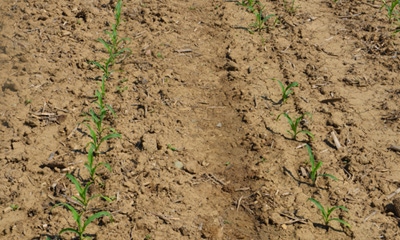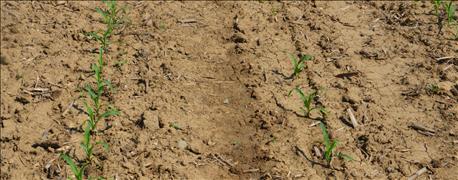
The farmers who manage the Crop Watch field agonized over it as it turned cool and wet after planting on April 27. It rained on 15 of the first 17 days in May in their location.
Here are two side-by-side rows that illustrated both what cool, wet soils can do and the fact that corn has a microclimate that can be as small as one row.
These pictures were taken 30 days after planting. The row on the left checked in at 28,000 plants per acre. But the row on the right only had 16,000 plants per acre.
When the photo was taken, it was obvious you wouldn’t tear up the row on the left. That wasn’t so obvious even two weeks earlier.

GOOD AND MEDIOCRE: The row on the left has 28,000 plants per acre. The one on the right has 16,000 plants per acre. Economics favor leaving both instead of planting over now.
Indeed, using information from a chart on expected yields due to various planting dates and populations, leaving the row on the left — assuming the entire field looked like it — would have been the right decision. The chart is in the Purdue University Corn & Soybean Field Guide. It’s based upon data collected over the years on corn planting date and population studies.
The numbers come out this way. The intended population of 32,000 plants per acre for corn planted April 27 would yield 100% of yield potential. Say that was originally 200 bushels per acre in this field. At 28,000 plants for a final stand, the yield potential will still be 99%, or 198 bushels per acre. That’s virtually the same yield as at 32,000, according to this particular set of data. If the farmer had elected to tear it up and replant May 25, the first day it was dry enough to get back into the field, he would have been looking at a top end of 87% of original yield potential, even if he achieved 32,000 plants per acre this time. That would be a maximum of 174 bushels per acre. Obviously, the effect of the planting date would take its toll.
Most people would likely tear up the row on the right, even on May 25. Some people did. Here’s the math.
At 16,000 plants per acre, half the intended stand, for corn planted April 27, the chart backed by data still says to expect 84% of original yield potential. That works out to 168 bushels per acre. It’s a big hit, but would tearing it up and replanting help?
If you planted May 25, the first available date in this case after a long weather delay, and if you got 32,000 plants per acre, you could have expected 87% of final yield, or 174 bushels per acre. That’s a net potential increase of 6 bushels per acre for replanting. Whether or not that pays might depend upon your seed replant policy and other input costs.
If you replanted May 25 and got 26,000 plants per acre, now the potential is 85% of original, or 170 bushels per acre.
The real kicker is if you wrestled with this decision until June 9. At that point, even with a perfect stand you’re looking at 68% of original yield, or less than 140 bushels per acre. The math would be clear — stick with what you have.
About the Author(s)
You May Also Like




